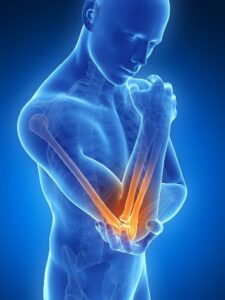What is Tennis Elbow?
Tennis elbow refers to pain originating from the tendon near the outer aspect of your elbow joint. This condition usually builds up over time and becomes increasingly painful if left untreated. Common aggravating activities include gripping or twisting with your hand, pushing or pulling with your arm, and writing or typing. These activities can cause discomfort or irritation.
Tennis elbow, also known as lateral epicondylitis, is a condition that commonly affects the tendons in the elbow. It is characterized by pain and inflammation on the outer side of the elbow, which can radiate down the forearm.
Why does it happen?
Repetitive movements and overuse of the muscles and tendons in the forearm often cause this problem. It is particularly common when gripping and lifting objects.
The mismatch in load refers to the excessive strain placed on the tendon compared to its capacity to handle the load. This can happen when there is a sudden increase in activity or when repetitive movements are done without enough rest. For example, tennis players may develop tennis elbow from repeatedly swinging the racket, while painters or carpenters may experience it from gripping tools for extended periods.
When the tendons are subjected to excessive stress, small tears can develop in the tendon fibers. Over time, these tears can lead to inflammation and pain.
In addition to overuse, other factors can contribute to the development of tennis elbow. These include poor technique or form during physical activities, inadequate warm-up or stretching before exercise, and improper equipment such as a racket with a grip that is too small or too large.
Overall, tennis elbow is a condition that occurs when there is an imbalance between the load placed on the tendon and its capacity to handle that load.
Understanding the causes, symptoms, and treatment options for tennis elbow can help individuals prevent and manage this condition effectively. For instance, if we replace the tendon in this example with a car engine. You would not expect a motorbike with a small engine to pull a 3-tonne trailer.
Same way, if we do not train the muscles and tendons in our forearm then we cannot expect them to perform when we do a full day of gardening/moving house/heavy lifting at the gym. On the other hand, we WOULD be able to rely on a V8 4WD to tow such a load.
So how do we get our tendons as strong as a V8?
EXERCISE! It can be tempting to believe we have to ‘rest’ the elbow and nurse it until pain subsides.
Unfortunately, if we do not use it, then it becomes progressively weaker and weaker making it even more painful and less capable. This is one of the main reasons that symptoms can persist for months on end and not seem to change or even worsen.
To prevent tennis elbow, use correct technique, gradually increase exercise intensity and duration, and take regular breaks for rest and recovery. Using equipment that is properly fitted and ergonomic can also help reduce the risk of developing tennis elbow.

How to treat tennis elbow
Treatment for tennis elbow typically involves a combination of rest, physical therapy, and pain management. Resting the affected arm and avoiding activities that exacerbate the pain is crucial for allowing the tendon to heal. Physical therapy exercises can help strengthen the muscles and tendons in the forearm, improving their capacity to handle load and reducing the risk of future injury.
Each patient can present differently, and it is important to be assessed by a Physiotherapist to first determine whether tennis elbow is the true source of pain. However, below are some common principles that you can get started on:
- Load management: Controlling the amount of load that you place on your forearms and elbow.
- E.g. If you do an intense upper body workout at the gym, it may not be wise to do a full day of heavy gardening the next day until 24-48hrs has passed and you can re-load the tendon again.
- If you had a particular heavy day on the tools or at work, it may be better to change the afternoon gym session to a lower body focused workout to avoid further loading that day.
- Specific tendon loading exercises:
- These can include but are not limited to: Banded or Dumbbell wrist extensions, Reverse curls, dumbbell wrist twists, dumbbell or banded wrist extension static hold
- All of the above are great exercises to get started on! However, it is always recommended that you seek professional advice to determine which is best for you, especially if they cause pain or exacerbate symptoms.
- Relief strategies: It is important to remember that the modalities listed below can definitely help with short term relief, but the tendon will need to be loaded with exercise for long term progress.
- Soft tissue massage, Dry needling or cupping (We utilise these in clinic!)
- Trigger ball/foam roller self-massage into the ‘meaty’ part of your outer forearm
- Ice or heat 20min on, 20min off, 20mins back on
There are several ways to manage pain. These methods may include using drugs like NSAIDs, applying ice packs, and using a brace or strap. The purpose of using a brace or strap is to support and ease pressure on the tendon. In severe cases, corticosteroid injections may be recommended to reduce inflammation and alleviate pain.
If you believe that you have tennis elbow, then call us at Dynamic Physio and Rehab, and schedule an appointment! We see too many patients that ‘put up’ with these symptoms and let the pain dictate what they are able to do.
So let’s take control of it together and get strong for the future!


